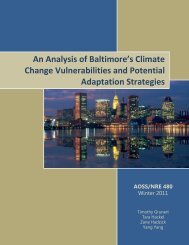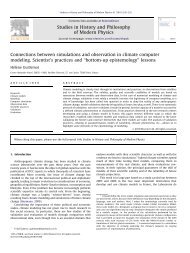Lal, Carbon Sequestration, PhilTransRoySoc 2008
Lal, Carbon Sequestration, PhilTransRoySoc 2008
Lal, Carbon Sequestration, PhilTransRoySoc 2008
Create successful ePaper yourself
Turn your PDF publications into a flip-book with our unique Google optimized e-Paper software.
Downloaded from rstb.royalsocietypublishing.org on April 14, 2010<strong>Carbon</strong> sequestration R. <strong>Lal</strong> 8231000 Kg C ha K1 yr K1 under humid and temperateclimates (<strong>Lal</strong> 2004b, 2005a,b,c). Normal rates ofSOC sequestration on agricultural soils are 300–500 Kg C ha K1 yr K1 . High rates are obtained withno-till farming, crop residue retention as mulch,growing cover crops in the rotation cycle and adoptingcomplex farming systems including agroforestry, INMincluding manuring and through restoration ofdegraded soils by afforestation.Adoption of RMPs on agricultural and forest soils is awin–win strategy (Follett 2001; <strong>Lal</strong> et al. 2003; <strong>Lal</strong>2004a,b, 2006). While improving soil quality andagronomic productivity, agricultural intensificationthrough adoption of RMPs also improves water quality,reduces non-point source pollution by decreasingdissolved and sediment loads, and reduces net rate ofCO 2 emission through SOC sequestration. It is a verynatural process (Morris 2006). However, for the SOCsequestered to be stabilized, it is important to understandthe stabilizing mechanisms (Six et al. 2002), limitations ofbiophysical ecosystems in C sequestration (Schlesinger1999; Sauerbeck 2001), and relevant economic andpolicy issues (McCarl & Schneider 2001). Trading of Ccredits may require several permits (at federal, state andlocal levels) and marketing procedures.(iii) Secondary carbonatesSoil C sequestration may also occur in SIC assecondary carbonates, and leaching of bicarbonatesinto the ground water. Secondary carbonates occur invarious forms as films, threads, concretions andpedants. They also occur as laminar caps, caliche andcalcrate (Gile 1993). In skeletal soils with high gravelconcentration, secondary carbonates occur as coatingson lower surfaces of stones and pebbles. There are fourprincipal mechanisms of formation of secondarycarbonates (Monger 2002; Mermut & Landi 2006).Marion et al. (1985) proposed that secondary carbonatesare formed through dissolution of CO 2 in thesurface layer followed by translocation and re-precipitationwith Ca C2 and Mg C2 in the subsoil. In contrast,Sobecki & Wilding (1983) described the secondmechanism based on capillary rise of Ca C2 fromshallow ground water and its re-precipitation in thesurface layer. The third mechanism of in situdissolution and re-precipitation was proposed byRabenhorst & Wilding (1986). Monger (2002)observed that pedogenic/secondary carbonates are ofbiogenic origin and are formed by activity of soil fauna(e.g. termites). Chemical reactions describing thedissolution of CO 2 are shown in the followingequations described by Mermut & Landi (2006):CO 2 ðgasÞ CH 2 O%CO 2 ðaqÞ CH 2 O;CO 2 ðaqÞ CH 2 O%H 2 CO 3 ;H 2 CO 3 %H C CHCO K 3;HCO K 3 %H C CCO 2K3 ;H 2 CO 3 %2H C CCO 2K3 andCa 2C ðaqÞ C2 HCO K 3ðaqÞ%CaCO 3ðcalciteÞCH 2 O CCO 2 :Secondary carbonates are formed in the soil pHrange of 7.3–8.5. There must, however, be sufficientquantity of Ca C2 and Mg C2 present in the soilsystem. Decreasing water content, decreasing partialpressure of CO 2 or HCO K 3 in soil air, and increasingthe products of Ca C2 or HCO K 3 in soil favour theprecipitation of secondary carbonates.In contrast to SOC, the rate of formation ofsecondary carbonates is low. In the deserts of southwesternUSA, Marion et al. (1985) estimated thatduring the Pleistocene the rate of deposition ofsecondary carbonates was 1.2–6 Kg C ha K1 yr K1 .Inanother study for the same region, Schlesinger (1985)estimated the rate of formation of secondary carbonatesas being between 1.2 and 4.2 Kg C ha K1 yr K1 .Alsointhe southwestern USA, Monger & Gallegos (2000)reported the rates of formation of secondary carbonatesat 1–14 Kg C ha K1 yr K1 . In Saskatchewan, Canada,Landi (2002) estimated the rate of deposition ofsecondary carbonates ranging between 9.9 and13.4 Kg C ha K1 yr K1 . For a non-calcareous parentmaterial, Machette (1985) estimated the rate of depositionranging between 1.7 and 6.1 Kg C ha K1 yr K1 ,andconcluded that rates are generally high in calcareous soils.Leaching of biocarbonates into ground water isanother mechanism of transfer of SIC into a lessactive pool, especially in soils irrigated with goodquality water (Nordt et al. 2000). The rate ofleaching of HCO - 3 in irrigated soils may be as muchas 0.25–1.0 Mg C ha K1 yr K1 (Wilding 1999). Thereare 250 Mha of irrigated land area globally. Thepotential of leaching of HCO K 3 in these soils may be62.5–250 Tg C yr K1 . With the exception of irrigatedsoils, there are not many technological options toenhance the rate of deposition of secondarycarbonates. Use of organic amendments (e.g. cropresidue mulch, manure and other biosolids) mayenhance activity of termites and other soil fauna,and also increase the formation of secondarycarbonates through biogenic processes. Use ofgood quality irrigation water to enhanceleaching of HCO K 3 is another relevant option forirrigated soils.4. BIOFUELSConverting biomass-derived sugars to ethanol andplant-derived oils and fats into bio-diesel is a viablestrategy to reduce use of fossil fuels and developalternate/sustainable sources of energy (Himmel et al.2007; Stephanopoulos 2007; Wald 2007). Of theworld’s total primary energy supply of 11.2 Pg of oilequivalent in 2004, 35.03% came from oil, 24.6% fromcoal, 20.44% from gas, 6.33% from nuclear and13.61% from renewable sources (Goldemberg 2007).Of the renewable sources, 2.48% was contributed bythe traditional biofuels (e.g. animal dung, cropresidues, wood products), and 1.91% by modernbiofuels. Only 3.22% of the primary energy wascontributed by hydro, solar, wind and geothermalsources.Biofuels, high on the political and scientificagenda, are related to C sequestration in twodistinct but interrelated aspects (figure 5): (i) soilPhil. Trans. R. Soc. B (<strong>2008</strong>)




